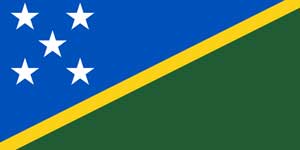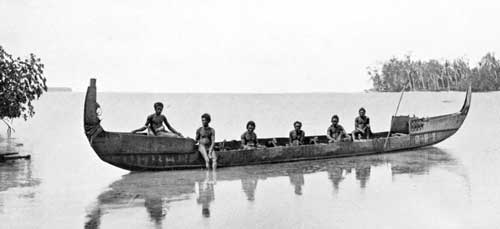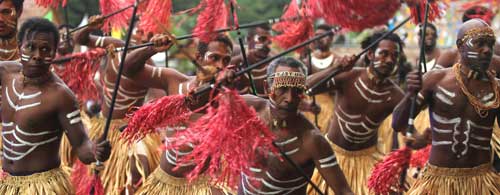Map
Flag

Quick facts
Official Name: Solomon Islands
Indigenous Peoples: Solomon Islanders
Official Languages: English and Solomon’s Pijin
Political Status: Independent, Constitutional Monarchy
Capital: Honiara
Population: 561,231 (2013 est., World Bank)
Greeting: Halo yu hao?
History and geography

The Solomon Islands are located east of Papua New Guinea and about three hours by plane north of Australia. Comprised of over 1000 islands, they cover a total land area of almost 28,000 sq km (11,000 sq mi), slightly smaller than the state of Maryland. Honiara, the capital, is located in the island of Guadalcanal. Other islands include Malaita, Choiseul, Sikaiana, the Shortland Islands, the Santa Cruz Islands, and Tikopia. Bougainville is geographically part of the Solomon Islands but politically is part of Papua New Guinea.
There are active and dormant volcanoes in the Solomons, but the islands are mostly mountainous with some low coral atolls. The climate is tropical and humid.
The Solomon Islands are believed to have been first settled as early as 1,300 to 1,000 BC by people from Island Southeast Asia. However, it is also believed that ancient Papuan-speaking peoples arrived in different parts of the Solomons as early as 25,000 to 30,000 BC. The earliest dates of human settlement have been established through carbon dating in a cave on Guadalcanal. The different tribes of indigenous Solomon Islanders, of course, have their own origin stories which establish themselves as having come from within the islands. The Austronesian-speaking peoples associated with Lapita cultural complex settled in the Solomons 1,200 to 800 BC, sailing from the Bismarck Archipelago.
In 1568, the first European to see the islands was Spanish explorer Álvaro de Mendaña, who named the islands after the biblical King Solomon and his land of gold. In the centuries that followed, missionaries, traders, blackbirders and labor recruiters and colonial administrators arrived to explore and exploit opportunities in the Solomons and its indigenous people.
In 1893, the British established a protectorate over the Solomon Islands in response to German colonial expansion in the area. However, by 1900, the Germans ceded their interests and the Solomons fell completely under British colonial rule. Around this time, several British and Australian companies established large coconut plantations and a wave of missionaries arrived as well, converting many of the natives to Christianity.
Some of the bitterest fighting of World War II occurred on this archipelago between the western Allies and the Japanese. The island of Guadalcanal was invaded by Japanese forces in July 1942, giving the Japanese close access to Australia. However, the American Navy bombed the island while American Marines landed on shore, swarming around and surprising the Japanese. Brutal fighting occurred in other islands as the Japanese maintained their hold for months, firing on the Americans with machine guns in caves among the hills. The Japanese were finally forced out in 1943. Honiara was made the capital and used to assist the American military effort in the Pacific. During this campaign, several islanders functioned as coastwatchers, providing valuable strategic information on Japanese naval, army and aircraft movement.
By the 1950s, local councils were established to govern the different islands. A constitution was created in 1974 and, following the lead of Papua New Guinea to the west which had achieved independence from Australia, the Solomon Islands became self-governing in 1976. The islands became independent two years later. However, ethnic violence, government corruption, crime, and a narrow economic base have undermined stability and civil society. In June 2003, the Prime Minister sought the assistance of Australia in reestablishing law and order, and within a month, an Australian-led multinational force arrived to restore peace and disarm ethnic militias. The Regional Assistance Mission to the Solomon Islands (RAMSI) has generally been effective in restoring law and order and rebuilding government institutions.
The Solomon Islands’ government is a constitutional monarchy with the current Queen Elizabeth II of the United Kingdom as the titular head, and is led by a Prime Minister, Governor-General and a unitary parliament.
Arts and culture

The majority of people of the Solomon Islands are ethnically Melanesian, but a small percentage are Micronesian and Polynesian, as well as ethnic Chinese. English is the official language, but there are 63 distinct languages among the different ethnic groups. Most people speak a type of pidgin language they call Solomon’s Pijin. Traditional ways of life are referred to by the Melanesian term kastom, and reflect the people’s mostly Melanesian roots. Most islanders live in close-knit communities of extended families, and while largely Christian, many still follow traditional systems of belief and land ownership.
Honiara is a fast growing city of approximately 70,000 people where modern urban life is mixed with ancient traditions. However the majority of Solomon Islanders still live in rural villages based in a subsistence economy of fishing, hunting and growing crops. People still barter and use alternative forms of currency, such as shell money. Most build houses on stilts that keep the house cooler, and are often without electricity, telephone or other modern amenities.
As well as agriculture and forestry, tourism is a very important sector of the small but growing economy.
Music and art play an important role in the lives of the Solomon Islanders. Traditional music uses instruments such as the slit drum and panpipes (raft or bundle of bamboo pipes of various sizes) and conch shell, as well as bamboo stamping tubes. In addition to handheld panpipes, the Solomon Islanders’ have another kind of panpipe instrument that is large and stationary, and it is the player who moves his head to blow into the different tubes.
Solomon Islanders are also known for crafts made from dark ebony hardwood often carved in beautiful patterns with in-laid mother of pearl. Baskets are finely woven with distinctive minute patterns and colored pandanus can be woven into shoulder bags. Woven wicker war shields, traditionally signifying power, status and prestige, are elliptical in shape and often decorated with tiny squares of nautilus shell. In fact, shells are crafted into everything from intricate shell money and threaded shell beads, to the round chest ornaments known as kap-kaps, which are made from precious materials such as turtle shell or giant clam shell. Another interesting art form are the canoe prow ornaments or nguzunguzu representing mythological spirits, which are painted black and have shell inlay designs based on face paintings used by warriors.
Melanesia delegations
- Australia
- Fiji
- New Caledonia
- Papua New Guinea
- Solomon Islands
- Vanuatu
